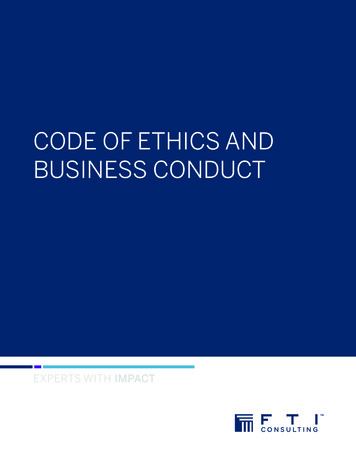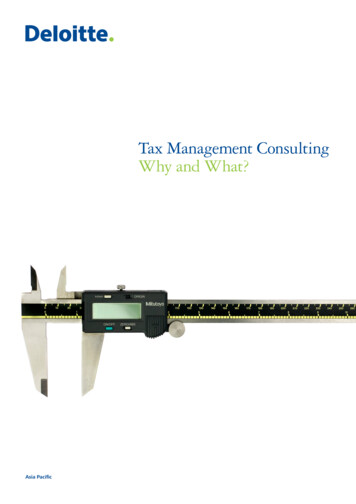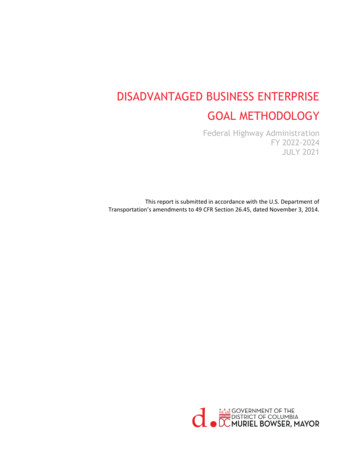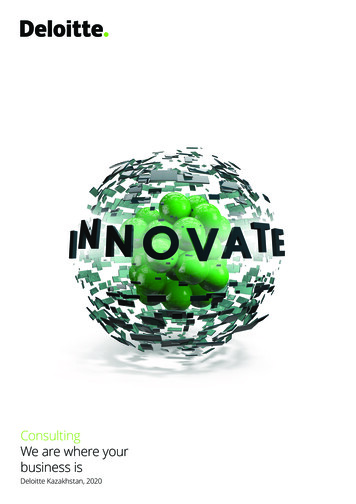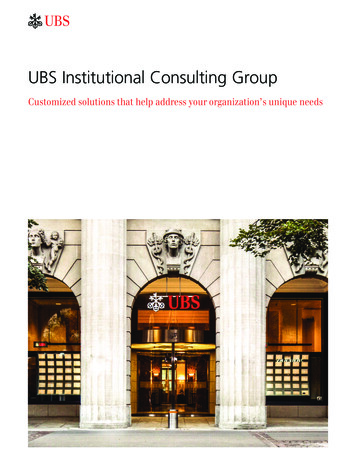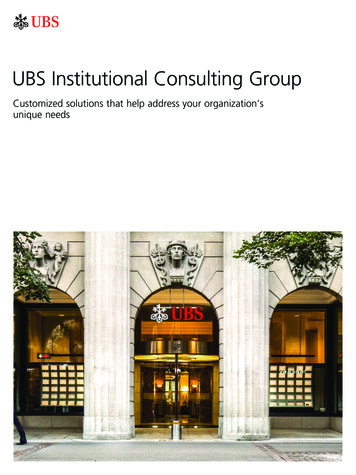
Transcription
M A N A G E M E N T C O N S U LT I N GJOURNALCONTENTS2357Editorial Board.So what makes a successfulconsulting project?Consulting Capabilities forOrganisational Change.The ‘World’s Newest Profession’ isno longer dispensable; what does itmean for consultancy firms?911 Becoming a Consultant.Evolution or Revolution?Alternative assignment scopes.VOL 1.1 - JUNE 2018ISSN 2631-987X
Editorial Board.Prof. Timothy ClarkDurham UniversityCalvert MarkhamCentre for ManagementConsulting ExcellenceProf. Daniel MuzioNewcastle UniversityBusiness SchoolMaximillian PullenBTProf. Andrew SturdyUniversity of BristolJeremy WebsterICMCI/Silver PebbleWelcome to the inauguralvolume of the Institute ofConsulting’s brand newManagement ConsultingJournal!Aimed at anyone working or interested inManagement Consulting, this new publicationwill highlight and debate management consultingissues, focusing mainly on those of practical value- exploring the application of concepts and theory.We hope that, in so doing, we can contribute to thepositive promotion of the management consultingsector and its practices.Our editorial article in this first edition looks atwhat constitutes success in the consulting world.The paper is co-written between myself and NeilFleming from Challenges Worldwide. Both Neiland I are part of consulting firms which have beennominated to represent the UK in the ConstantinusInternational global consulting awards. ChallengesWorldwide fared particularly well last year,securing runner-up. Our paper draws on theChallenges Worldwide experience and aims toshine a spotlight on what ‘Successful Consulting’looks like.Also in Vol 1.1, we’re delighted to feature papersfrom three prominent UK writers on managementconsulting: Dr David Biggs; Dr Julie Hodges;and Dr Olga Matthias; plus one from a formerChair of the International Council of ManagementConsulting Institutes (ICMCI), Brian Ing. Thesefour papers bring additional perspectives andcontributions to supplement our understanding ofthe management consulting world - I hope you findthem interesting and useful.The Management Consulting Journal will bepublished twice a year, with Vol 1.2 coming inNovember 2018. We welcome articles from bothscholars and practitioners alike, and look forwardto receiving your contributions. Visit our websitefor guidelines and a template for submissions.Dr Simon HaslamChair, ICMCI Academic FellowsActing Editormcjournal@managers.org.uk2
M A N A G E M E N T C O N S U LT I N GJOURNALSO WHAT MAKES A SUCCESSFUL CONSULTING PROJECT?Dr Simon Haslam, FMR Research &Neil Fleming, Challenges WorldwideIntroductionWhat constitutes a successful consulting project is aquestion that has attracted interest from practitioners andresearchers alike. Aside from getting the invoices paid,successful projects provide consulting firms with additionalbenefits and value. Marc Baaij, in his Introduction toManagement Consultancy (2014) suggests the evaluationof the success of a consulting project potentially helps aconsulting firm in four ways: 1) it offers a reference pointby which the quality of the project’s deliverables can bejudged in relation to the fee charged; 2) it enables thescrutiny of the degree to which it contributed to the valuecreated by the project, compared to, for exampleserendipitous circumstances; 3) it can provide the data tohelp the appraisal and development of consultants; and 4)it leads to the creation of learning and credentials for thefirm’s future work, in the form of reputational collateral,references and knowledge.How success is measured varies. For some consultingfirms, indicators like repeat business or recommendationsserve as proxy measures of the standing of the firm inthe eyes of the client. Indeed, the rise in popularity ofthe Net Promoter Score (Reichheld, 2003) is based onsuch thinking. IBM Partner Sally Cross (O’Mahoneyand Markham, 2013) reminds us that success might bedetermined differently by the consulting firm and by theclient. Although the perspectives might be different, ideallya consulting project should be deemed successful from bothvantage points. Fiona Czerniawska’s work (2006) suggeststhe determination of success in practice is more artistic thanscientific. She draws attention to the paucity of metrics inclients’ evaluations of the results of consulting projects.This characteristic increases the subjectivity by whichthe success of consulting projects is determined, placinggreater emphasis to the process adopted and the conduct ofthe consultants involved.This paper looks at one consulting project whose successwas endorsed by a distinguished panel of experts. Eachyear, the International Council of Management ConsultingInstitutes (ICMCI) organizes the ‘Constatinus Awards’, tocelebrate consulting project excellence. The net for nominations is cast worldwide, which results in a rich variety ofentries. The Constantinus Awards represents a consideredindependent perspective of what a successful consultingproject looks like. Perhaps not surprisingly, the focus of theattention is more from the external stakeholdervantage point, rather than internal metrics such as projectprofitability. In 2017, a UK-based consulting firmChallenges Worldwide came runner-up in the global award,having secured the British title en route. With ChallengesWorldwide’s blessing, this paper explores what successlooks in the eyes of the Constantinus Awards’ judges – boththe questions asked and the answers given. As a result,this insight may help consulting practitioners reflect onthe orientation of their own consulting projects and whereemphasis might well be oriented in order to be judged asparticularly successful.BackgroundBefore looking into the particular consulting project thatcaught the eye of the Constantinus judges, it’s helpful tolearn more about Challenges Worldwide and the type ofwork it undertakes. Challenges Worldwide hasProfessional Consulting training from its affiliate organisation Challenges Catalyst, a CMI (Chartered ManagementInstitute) strategic partner in the UK. This is one exampleof Challenges Worldwide’s linkages with recognizedpathways around consulting professionalism.The Constantinus Awards nomination was based on oneof Challenges Worldwide’s interventions – a project withBooomers International Ltd. This is a company basedin Kumasi, Ghana, engaged in manufacturing bamboobicycles, who were looking to improve operational capacityalongside raise investment and access to new markets,specifically the UK.delivered private sector development interventions inover 50 developing markets around the world to smalland medium enterprises with high growth potential since1999. Since 2014, as part of a UK Aid programme, it hassupported over 1,000 junior business support associates todeliver over 650 consulting interventions with small andmedium-sized enterprises across Ghana, Rwanda, Uganda,and Zambia, amounting to over 90,000 on-site consultingdelivery days.Challenges Worldwide’s core consulting staff areaugmented by a team of Business Support Associates.These are volunteers aged between 18 and 25, who workdirectly with Challenges Worldwide’s overseas clients. TheBusiness Support Associates receive the Level 5 CertificateSuccess looks like This section examines the nature of success in consultingprojects, with specific reference to the lines of enquiryposed by the Constantinus Awards and the responses fromChallenges Worldwide.The nomination form seeks a description of the project.And Challenges Worldwide answered this with directreference to the consulting cycle. The consulting cycleexists in various forms, from the six-stage processarticulated by Lippitt and Lippitt to the three-part one in therecent ISO 20700 Guidelines for Management ConsultingServices. The consulting cycle for this particular projectwas articulated by Challenges Worldwide under thefollowing headings: recruitment and exploratory meeting;contract development; set-up; data collection and analysis;presentation; implementation; review and implementation.There are some key observations in ChallengesWorldwide’s responses, beyond the point of viewing theconsulting cycle as a broad-based construct which need tobe personalized to the particular consulting situation –in content and terminology.At the beginning of the consulting cycle, ChallengesWorldwide explain the fit between the client contextand Challenges Worldwide’s own focus and ability tobe valuable to the client. Challenges Worldwide look tosupport high growth potential enterprises in sectors thatwill contribute to market and community level change.Our three main sectors are: agriculture – one of the largestemployers in developing markets; craft – high number offemale representation; and alternative energy – providingcheap and/or reliable power supply to communities. WithBooomers we immediately saw growth potential for takingpart in our programme due to the apparent trade linkagesand investment potential to grow the business.The contract development stage involved a two-stepprocess, which recognizes the pragmatics around scopingterms of reference ahead of embarking on the investigationthat forms part of the consulting intervention. Booomersand Challenges Worldwide signed an initial Terms ofReference detailing the three-month intervention fromanalysis to implementation. Post analysis stage, anappendix to this document was signed with more focusedintervention deliverables by Challenges Worldwide’sbusiness support associates. In the set-up phase and withthe establishment of the project team, ChallengesWorldwide staged an Enterprise Seminar as a landmarkevent at the start of the project with the additional rolesof sharing/shaping the project process and facilitatingdevelopment of communication between the individualsin the Challenges Worldwide team and the Booomersorganisation.In the data collection and analysis phase, ChallengesWorldwide employed an approach used by many consultingfirms, namely to deploy a proprietary analysis framework,which is nevertheless underpinned by a sound researchbase. In this case, Challenges Worldwide used a 51-pointdiagnostic which helps generate data for insight into areaslike market analysis, industry structure and productionprocess mapping. As the project moved into thepresentation stage, Challenges Worldwide was able toidentify a series of six short term recommendations. Themerits of ‘quick wins’ and ‘low hanging fruit’ with theassociated benefits for project momentum and stakeholderbuy-in are well recognized in the consulting literature.3
M A N A G E M E N T C O N S U LT I N GJOURNALSO WHAT MAKES A SUCCESSFUL CONSULTING PROJECT? (Cont.)The Constantinus Awards nomination form seeks dataaround the specific benefits achieved by the consultingwork. This draws attention to both the importance anddifficulties around specific metrics in consulting work.The first area referred to was the increased revenue/profitgenerated for the client as result of the consulting work.Challenges Worldwide’s response that, having recentlycompleted the project it was too early to determine adifferent, draws attention to the complications aroundtimescale and causality when looking at outcome-levelindicators of consulting work. But of the ChallengesWorldwide scope of work included a post project impactassessment, six months after the completion of the work.In relation to process and output measures, ChallengesWorldwide was able to provide data generated with the helpof its 51-point diagnostic. This showed improvements forthe client in areas like leadership, sales and marketing andproduct processing. While the determination ofquantitative data is not an easy endeavor, ChallengesWorldwide’s response reminds consultant of the value ofhaving a considered response to question by a transparentmethod, especially when the consulting work is open toexternal scrutiny.Challenges Worldwide was able to explain morefar-reaching benefits of its work with Booomers, as theConstantinus Awards sought illumination of more societalimpacts of consulting work. With managementconsultants often being criticized in the press for failingto make positive contributions to society and not beingseen a part of the ‘case for good’. With what many see asa growing disparity between societal values and corporatebehavior, this serves an encouragement to principals ofconsulting firms to retain sight of a broader responsibilityto society and the consulting profession.In response to questions about societal benefits and longterm impact, Challenge Worldwide drew attention toBooomers’ work to support human development throughjob creation and educational development, whilst providinga sustainable carbon neutral and ‘green’ alternative mode oftransport. And the value of enabling children in rural areasto have a better means of going to school; educationdevelopment and youth employment is the key focus,currently providing bicycles as part of a UNICEFprogramme.In relation to improving innovation strength (which is aboutthe client’s capability and cultural development),Challenges Worldwide was able cite activity in helpingBooomers diversify its product range in the bike andbamboo market though linking to new markets, andintroduce renewable energy to their production processas part of investment raise.A major component of Challenges Worldwide work iscapacity building. Its narrative about the Booomers projectform referenced its eighty-eight days on client site, and itssixteen CMI (Chartered Management Institute) trainingsessions. The Constantinus nominations form looked for anexplanation of how the learning from the project wastransferable to a wider audience. Beyond the capacitybuilding that formed part of the project , ChallengesWorldwide made reference to more wide dissemination oflearning enabled by the project. One example – its businesssupport associate teams were able to share CMI learningand implementation across four International marketsthrough its peer to peer learning platform. This allowedyoung people to engage with different city and countrygroups, to improve consulting delivery.As would be anticipated the Constantinus Internationalnominations form sought feedback on client satisfaction.The Challenges Worldwide nomination included a positiveendorsement from the primary client.I felt the impact of the Challenges WorldwideProgram in that it changed the face of my business.Through that program, I was able to have a betterstrategy for new markets.The gravity of the client endorsement was added to bysome comparative data included by Challenges Worldwide.While a team of consultants might commit strongly andconsistently across its projects, a major variable in thesuccess of consulting work (Markham) is the client.Challenges Worldwide was able to report that its projectmetrics suggested its work with Booomers led to animprovement in operational output for client of 30%above the norm for this type of project.ConclusionsThe experience of Challenges Worldwide helps shine lighton what particularly successful consulting looks like. Theability to demonstrate project delivery to agreed objectivesseems to be a hygiene factor rather than a distinctivequality in the way success is judged. The Constantinusexperience points to three qualities over and above this.First is the presence of recognized good practice in theconsulting firm. Challenges Worldwide’s submission madedirect reference to recognized pathways to developingconsulting competence and approaches such as theconsulting cycle (the consulting cycle forms part of the newISO 20700). It may be no surprise that the ConstantinusAwards judges were positively disposed toward suchformalized approaches which the ICMCI helped create, butthe take-away for practitioners is the importance of beingable to demonstrate recognized good practice. Second arethe characteristics of the project itself. The more eyecatching consulting work is that which is interesting andout of the ordinary. Challenges Worldwide isunconventional in terms of its both business model andproject for which it was nominated. Particularly successfulconsulting is probably distinctive consulting well executedrather than routine work well executed. Third is theimportance of wider-value in consulting. Managementconsultants may not have enjoyed universally good pressin recent years, so the merits of consulting endeavors thatfocus on social justice and a greater good have a particularappeal. It could be said the business world needs to raiseits game in the areas of enlightened value, environmentaland social responsibility, so consulting projects whichhelp blaze this trail are likely to enhance the reputation ofthe consulting profession as well benefit the stakeholdersfor whom they were intended. This was certain a positiveattribute of Challenges Worlwide’s involvement withBooomers International Ltd.Kwabena Danso, CEO, Booomers International Limited.4
M A N A G E M E N T C O N S U LT I N GJOURNALCONSULTING CAPABILITIES FOR ORGANISATIONAL CHANGE.Dr Julie Hodges, Durham University Business SchoolIntroductionTo be able to implement and sustain change successfullyrequires consultants to possess, what is referred to as, asort of ‘gift’ specific to the consulting industry; a ‘naturalconsulting skill’ (Kakabadse et al, 2006). It is like being amusician, most people can play badly but it is the peoplewho can play well who can become excellent. To becomeexcellent requires not just skill but specific capabilities:skills; knowledge; attitudes; and experience.There have been many attempts to define the breadth ofcapabilities that a consultant needs in order to beconsidered fully competent with various generic lists (forexample, Anderson, 2012). De Caluwe and Reitsma (2010)list ten capability categories which comprise: enterprising;showing resilience; organizing; performing; analyzing;considering; facilitating; influencing; managing; andinspiring confidence. Instead of breadth in a large numberof capabilities, some researchers suggest the need for deepexpertise in a small number of areas. Kenton and Moody(2003), for example, describe three areas where consultantsneed to be skilled: personal and interpersonal effectiveness;working as an agent of change; and consulting skills. Ina survey of consultants Kakabadse and colleagues (2006)found that the following five skills were necessary tobecome an efficient consultant: experience; functionalskills; ability to listen and question; objectivity; andself-awareness. In order to meet the challenge of consultingWickham and Wickham (2008) say that the consultant mustdevelop a skill profile that allows them to call upon abilitiesin three key areas: an ability to manage the consultingexercise as a formal project; the ability to manage theanalytical skills necessary to gain an understanding of theclient business and the possibilities it faces; and an abilityto communicate ideas and positively influence others. Suchexpertise in a small number of specific areas enables aconsultant to build in-depth capabilities rather than be a‘Jack [or Jill] of all trades’.Trying to identify relevant capabilities for consultancy forchange from the vast lists, which prevail, is a dauntingprospect. In an attempt to address this Wilcox and Jenkins(2015) suggest grouping capabilities under the fourheadings of exploration, envisioning, engagement, andexecution. Such groupings are helpful in that they tend tomirror the key stages of most consultancy approaches butare nevertheless vague and generic.Consultancy capabilities for organisational changeTo identify the most relevant capabilities, I conducted asurvey with over one thousand consultants from 20countries and 25 different organisations, along with over500 client managers from 30 organisations to helpidentify the key capabilities. Internal consultantsaccounted for 45% of respondents and externalconsultants 55%. The managers were primarily from theprivate sector (70%), while the majority of consultants whoresponded specialised in Organisation Development (40%);Human Resources (20%); Technology (15%); Operations(15%); and Finance (10%).The sample for the study was constructed usingprofessional and informal networks which is an approachregularly employed as a means of gaining access(Gummesson, 2000). A snowball technique was used sothat individuals who agreed to participate recommendedother potential respondents (Atkinson & Flint, 2001).One danger of “snowballing” is the potential for clonedrespondents with each person at risk of being much likethe next in terms of traits, interests or patterns. To preventthis happening ten separate “snowballing” chains werelaunched, each starting from a different networking source.Participants were asked to rank in order of importancethe most relevant capabilities required for consultancy forchange. The top ten capabilities identified were: buildingand maintaining relationships; developing andsustaining trust; managing emotions; gaining commitmentand engagement to change; facilitating creative dialogue;resilience; having a tolerance for ambiguity anduncertainty; having political astuteness;managing power dynamics; and being an effectivecommunicator. Based on the high level findings from thesurvey we will now briefly describe each of thesecapabilities and their importance in conductingconsultancy for organisational change based on thesurvey findings and further research.Building and maintaining relationshipsAs one participant pointed out, “Consultancy is aboutpeople and the consultant’s role is to firstly establish asound relationship with the client and attempt to makethem feel comfortable with the consultant and theconsultancy process”. This foundation is critical to theopenness, sharing, and honesty that are necessary duringorganisational change (Jamieson and Armstrong, 2010).The need to create a sound relationship is vital. The key toa successful relationship between consultants and clientsdepends on the proactive behaviour of the consultant,which means that the consultant needs to think even ofthose needs and requirements of which a client has not beenaware, and helps the client to see such needs andpossibilities. To achieve this requires a positiveclient-consultancy relationship which is built on trust.Developing and sustaining trustA number of respondents in the survey pointed out thata client’s willingness to share information will dependon how much they trust the consultant. To reinforce theimportance of trust, Cope (2010) has developed a helpfulmnemonic of TRUST: Truthful – the consultant and the client must betruthful to one another. Responsive –the consultant needs to engage totallyin the client’s world. Uniform – a consultant must be consistent in theirideas and attitudes towards the engagement. Safe – given some of the emotions a client may feelit is important that the client feels safe working withthe consultant. Trained – it may sound obvious but it is importantthat the client believes the consultant is competentin the area of expertise that they are being consultedabout. This will be based on their work experienceand credibility, and if they are external consultants,then also on the reputation of the consulting firm forwhich they work.The ability of a consultant to build trust and gain thecredibility of the client is a key factor for building aneffective client-consultant relationship.Managing EmotionsParticipants emphasised that the relationship existingbetween consultants and clients involves an emotionaldimension that must be managed. In support of this therelationship between the consultant and the client has beendescribed as an ‘emotional duet’, in which the consultanthas to learn to ‘recognise, deal with and respond to theclient’s emotions’ (Stumpf and Tymon Jr, 2001: 49).Lundberg and Young (2001) go as far as to say thatconsultants who are called in to provide expertise andsolutions on pragmatic problems such as change, are in factimplicitly called in to provide emotional support. Indeedorganisational change is not only about dealing with thechange but also about dealing with feelings and emotionsof the different members involved in the process (Hodges,2016). This is important to recognize because theconsultant needs to avoid finding themselves in a situationwhere, although a good piece of consultancy was deliveredthe client is disappointed because emotions were notmanaged carefully.Emotions are involved throughout a consultancyassignment, hence consultants must be able to create aclimate where clients feel that they can trust theconsultant. However, in order to reach such a stage, theconsultant must dedicate their full and undivided attentionto the client and their objectives and place the client’sinterest ahead of their own. This involves consultantscarefully managing and understanding their own emotionsas well as those of the client. So consultants need to beaware of their own abilities and emotions and know theirstrengths and areas for development.Gaining commitment and engagementGetting commitment to a change is part of the process ofengaging people in organisational transformations (Hodges,2018). A consultant who is trying to help an organisation togo through a transformation, needs to help people not onlyto understand it but also to engage and be committed to it.Participants in the survey described this in terms of ‘gettingbuy-in’ for change. Engagement and commitment need tocome primarily from the client but also from keystakeholders. For example, frontline employees are theones responsible for behaving in ways conducive toproposed change and often have to learn new ways of doingthings. Commitment to change is therefore an importantenabler of change, if employees are not engaged then verylittle will change. One way to build commitment is forconsultants and clients to create an environment in whichthe people most affected by change have a role in shapingit. This involves helping individuals to understand whatthe rationale is for the change. Involving front-line staff inthe diagnosis and joint problem-solving in order to identifysolutions will help to gain commitment at an early stagebecause people are more likely to react positively if theyhave been involved in defining the solution rather thanhaving them imposed on them.ResilienceSurvey participant stressed the need for consultants tobe resilient. This requires developing an ability to thinkpositively, maintaining perspective, developing a strongnetwork of supportive relationships and taking care of5
M A N A G E M E N T C O N S U LT I N GJOURNALCONSULTING CAPABILITIES FOR ORGANISATIONAL CHANGE. (Cont.)one’s mind and body. In an article entitled, ‘Increase yourresilience to change’ Proctor (2014) identifies thecharacteristics of resilient people as optimistic,self-assured, focussed, open to new ideas, willing to askfor support, structured and proactive. These componentsof resilience all play a vital role in enabling consultants tomanage stressors in a proactive, adaptive and positive way.Resilient consultants are able to draw on thesequalities at the right time and understand when, forexample, being proactive is more important thanseeking support. Resilience can help to maintain higherperformance levels, improve a consultant’s sense ofwellbeing and aids them in coping with fluctuatingemotions. It also helps them to deal with different types ofclients and organisational transformations within differentcontexts without being overwhelmed.Tolerance of ambiguity and uncertaintyParticipants emphasised that consultants must be able tocope with ambiguity and uncertainty. Ambiguoussituations can be defined as completely new situations withno familiar cues or precedents, or as apparently insolublesituations which cannot be solved in the usual way.Such ambiguity creates uncertainty and isuncomfortable and can lead to individuals wanting toquickly resolve issues. The desire to achieve quicksolutions may be compounded by a client who questionsthe capability of the consultant when the consultantresponds to the client’s ‘what’s next’ questions with‘I don’t know’ or ‘I am not sure where this is going atpresent’. Rather than agreeing a quick fix toleratingambiguity means being comfortable during a period ofuncertainty and taking time to delve into the root causesof an issue.Political AstutenessJust providing the right solution is not enough; surveyparticipants highlighted that consultants have to be ableto deal with the politics within the client organisation.Organisational politics are often described as a turf gameinvolving a competition of ideas (Buchanan and Badham,2009) which consultants may be forced to play. Politics are,however, a naturally occurring phenomenon inorganisations and are often resistant to attempts to stifleor eradicate them. Rather than attempting to do so, themore effective response is for consultants to recognise andaddress them when appropriate. There is, therefore,a need to learn how to read the political context of achange initiative, its political manoeuvring and informalsocial network, in order to bring about the desiredoutcomes.Managing the power dynamicsCreating effective organisational change conversationsSummarisingParticipants in the survey emphasised that consultantsneed to know where the power lies when dealing withorganisational change, which means not only ‘positional’(appointed) power but also ‘relational’ (people) power,since without this knowledge the progress of change canbe severely impeded. Consequently it is important to knowwho has power, how to recognize how other peopleexercise their power and what power tactics to use.Robbins and colleagues (2010) have identified ninedistinct tactics from the research which are:The ability to create organisational change conversationsis a core element of consultancy for change which surveyparticipants highlighted as a key capability. This can beachieved through effective listening, questioningand summarising.Along with listening and questioning con
successful projects provide consulting firms with additional benefits and value. Marc Baaij, in his Introduction to Management Consultancy (2014) suggests the evaluation of the success of a consulting project potentially helps a consulting firm in four ways: 1) it offers a reference point by which the quality of the project's deliverables can be



